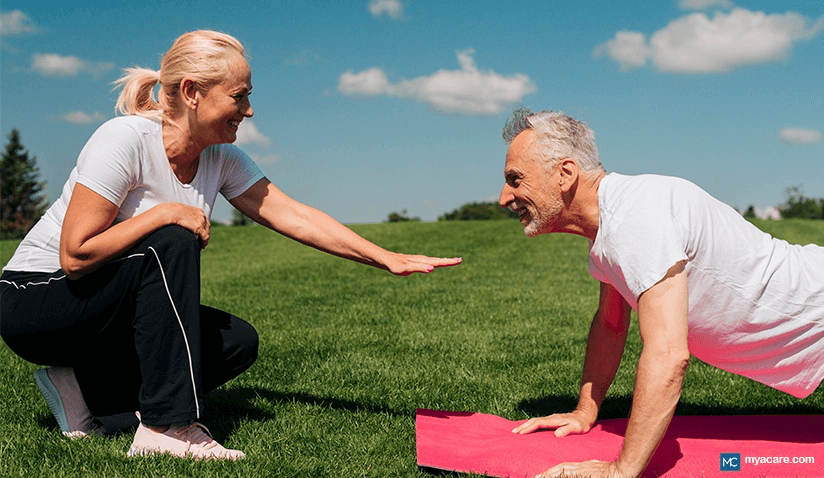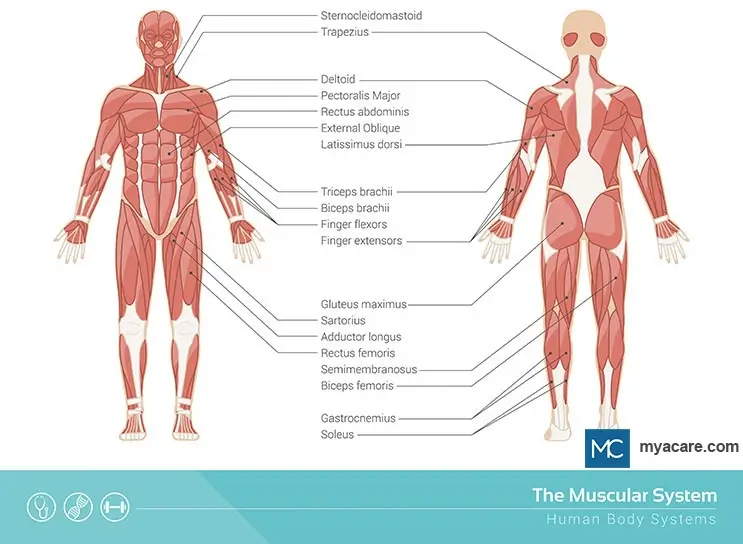Why Muscle Mass and Strength Are Important in Everyday Life

Muscle Mass and Strength are Important
Which Muscles we Use for Everyday Tasks
Muscles are an important part of the body, making up somewhere between 30 to 40% of all the tissues. It is essential that muscle tissue is built and maintained throughout the lifespan.
Read further to learn about the different types of muscle tissue in the body and why having strong muscles and keeping track of body fat percentage to ensure you have a lean body mass is important for your everyday life.
Types of Muscle Tissue
There are actually three types of muscle tissue found in the body. The microscopic structure of these muscle types differs because they are made for specific functions in the body.
- Skeletal Muscle: This is the muscle tissue that has a striped appearance and only contracts when you want it to. In other words, the contraction is voluntary. These muscles attach to the bones of the body where they act as levers and contract and relax to bring about movement of the limbs. You also find these muscles on the face where facial expressions can be made.
- Smooth Muscle: The smooth muscle, as the name implies consists of non-striated (not striped) tissues that contract without conscious thought. These are involuntary muscles that are controlled by the autonomic nervous system of the body. The smooth muscle lines many organs such as the stomach and intestine and contracts to move food along the gut when needed.
- Cardiac Muscle: This muscle type is only found making up the heart. These cells are unique because they have special structures called intercalated discs that allow for involuntary synchronous contraction of the muscle. This is possible because the discs ensure that the nerve impulses spread quickly through the muscle cells and in a particular sequence. This is important because the heart has to contract in a set rhythm.
Why Muscle Mass and Strength are Important
Muscle mass is important, not only for movement but for many functions in the body that rely on muscular contractions. Having strong muscles is more than about appearance, it is closely linked to health.
Cardiac and Smooth Muscle
- The heart is mostly made of muscle tissue with this layer called the myocardium. Having healthy heart muscle is essential so that your heart is able to contract and squeeze blood out into the vessels that carry it around the body. The heart is a muscular pump that keeps all the organs of the body functioning by supplying them with oxygen-rich blood loaded with nutrients.
- Organs lined with smooth muscles, such as the stomach and intestines would not function without this tissue. The contraction of muscles is what propels our food along and through the gut. Even the gallbladder has a smooth muscle layer to allow it to contract to squirt bile into the intestines when fat is present.
Skeletal Muscle
- Skeletal muscle mass is crucial because it not only allows us to move our body but also protects the joints of the body.
- As the body ages, lean muscle is lost, which is another reason why it is paramount that a person continues to keep their muscles strong to prevent the risk of too much muscle loss over the years.
- Weak muscles may also increase the odds of back pain and poor posture, particularly as you age. It also may lead to poor balance and instability; this can make dangerous falls more likely in old age.
- Having strong core muscles is important because these are involved in supporting the back and are involved in many daily movements of the torso and limbs.
- Strengthening muscles is important and also has the benefit of increasing your endurance and overall fitness level
- Exercise can help reduce the likelihood of developing any musculoskeletal disorders.
- Exercise to strengthen muscles can also help build strong bones and reduce the risk of osteoporosis later in life.
- Osteoarthritis is a condition more common in old age but exercising your muscles helps the joints to stay flexible and may help alleviate some discomfort and slow the progression of this illness.
Which Muscles we Use for Everyday Tasks
Below are listed only some of the many skeletal muscles that are used each day as we go about our daily lives. These muscles all attach to bone by connective tissue called tendons.

Head and Chest Muscles
- Eye muscles: There are 6 eye muscles that anchor the eyeball and that move our eyes to look around.
- Masseter and pterygoids: Muscles of the jaw enable the mouth to open and the jaw to move up and down, and side to side for biting and chewing.
- Intercostals and diaphragm: Without these muscles, we would not be able to breathe. The intercostals are on the rib bones and the diaphragm is a sheet of muscle found between the thorax and abdomen. These muscles contract and relax to allow us to draw air into our lungs.
- Pectoralis and trapezius: The pectoralis is the big chest muscle that allows sideways and rotational movement of the arms. The trapezius is a triangle-shaped muscle on your back that helps you move the neck, head, and arms.
- Levator scapulae: The name roughly means “lift scapula” and it is what allows us to lift our shoulder blades (scapulae) as we move our arms backward. This muscle is joined between the back of the scapulae and the backbone.
- Sternocleidomastoid: This is a thick band of muscle found attaching the collarbone and breastbone to the side of the head. It supports the head and also is in action whenever you move your head.
- Suboccipitals: These are a group of small muscles that join the head to the first few bones of the vertebral column. It keeps your head attached and they help you move your head up and down and also in rotating your head.
These are the muscles found between the thorax and the pelvis.
- Rectus abdominis: This is colloquially known as the abs, the outermost layer of muscles of the abdomen. These help with overall posture and support of the pelvis and help the body to bend over.
- External and internal oblique muscles: These are the middle layer of abdominal muscles. You use these when you bend over or twist your body to the side. Activities we do each day include bending the body to pick something up or moving sideways to reach for an object on the side.
- Transverse abdominis: These are the innermost abdominal muscles that provide more support and stability to the abdomen and covers the connective tissue surrounding the internal abdominal organs. It plays a role in allowing you to bend and move your body sideways.
- Latissimus dorsi: This muscle wraps around the middle and lower back. It functions to stabilize the back and helps when you move your shoulders. Any time you open a door or lift a heavy item off the floor, this muscle is in action.
- Erector spinae: These muscles attach to the back of the skull, and the backbone and run down to the sacrum (a part of the pelvic girdle). They enable you to flex your back and twist sideways. These muscles are crucial in supporting your neck and spine. Strengthening these muscles is important in helping support your back and reducing back pain.
Arm, Leg, and Buttocks Muscles
- Biceps and triceps: These are muscles on our upper arms that contract and relax allowing our arms to extend and flex. They help us to open doors, pick up and carry objects.
- Quadriceps: This is a group of four muscles on the thigh that help you stand up from a sitting position and walk from place to place. They are in use when you get out of your car or walk around the shop. When you climb stairs, these muscles are also involved.
- Hamstrings: These are the muscles at the back of the leg on the upper part. They help with many movements including climbing stairs and bending the knees when you squat down.
- Gastrocnemius and soleus: The calf muscles of the leg are what allow you to stand up and that provide support for the ankle.
- Gluteus: These are often called glutes and are actually the muscles found on the buttocks. They are important in allowing you to extend your thigh and allow flexion of the trunk. They are in action when a person bends over to pick up an object or a small child.
- Muscles on the hands: Too numerous to mention, the muscles making up the palm of the hand and the wrist allow for fine motor movements. Objects can be gripped, picked up, and held thanks to our muscles and joints.
- Muscles of the feet: These provide support and stability when you stand, and enable the toes to move.
Signs of Muscle Weakness
One of the first signs of weak muscles is struggling to do some of your normal daily activities.
- Lifting objects and standing up from a chair may be take more effort than usual.
- You might find you feel tired more quickly and need to rest more than usual after any type of physical activity.
- Muscles may feel sore after moderate activity, a further sign that you have lost muscle strength.
- A further sign of muscle weakness is a loss of endurance.
- You may not be able to walk or run as far as you used to without having to stop and rest and your muscles will feel tired.
Causes of Muscle Weakness and Atrophy
The signs of muscle weakness can be from a lack of exercise but can also be signs of debilitating and serious illnesses like multiple sclerosis, ALS, or fibromyalgia, so if you are concerned you should see your doctor.
Temporary weakness and pain in the muscles can be due to viral and bacterial infections but if the problem does not improve after you have recovered you should consult a doctor.
Muscle weakness can be a result of having lost muscle tissue. Muscle loss (atrophy) is also known as Sarcopenia and it can occur due to illness but is common in people over age 60 and accelerates after age 75. This is a natural part of aging that happens because the body does not respond as well to hormones and often people are less active when they are older.
While it is common to lose muscle mass as we age, much can be done to help maintain muscle mass. A combination of strength and resistance exercises is helpful in building muscle and increasing fitness levels.
Exercises for Strengthening Muscles
Physical activity is important in keeping the body healthy but a person should always check with a doctor first before beginning any exercise program.
Joining a gym may be a good idea if you are serious about getting into shape. However if you have never worked out before, it could increase your risk of injury to train without supervision, it might be a good idea to invest in a personal trainer to get started. Some of the following exercises are examples of ways to start building muscle mass.
- Quadriceps extensions and hamstring curls: These exercises work for both sets of muscles and are done using different gym equipment. You can also sit in a chair at home and use a large ball to exercise these muscle groups in a similar way.
- Weight lifting/resistance training: You can lift weights at the gym or start small by buying your own set of dumbbells to lift at home. If you plan to lift heavy weights it may be safest to do so at a gym with a trainer who can give you guidance on how to exercise safely.
- Push-ups and sit-ups: No special equipment is needed to do push-ups and sit-ups, so this can be done at home every day to help strengthen the core muscles of the body. This is important because the core is responsible for supporting your internal organs and your backbone. It also allows you to bend over and lift objects and move sideways. The push-ups and sit-ups will also help flatten the stomach and strengthen the arms.
- Squats and lunges: Squats help to strengthen and condition your legs, while also exercising muscles of the back and abdomen. Lunges are good for building big leg muscles.
- Resistance bands. These bands can be helpful in building strong muscles throughout the body, including the core. They are a low-cost option and can be carried with you from place to place, making it easier to exercise.
Conclusion
Maintaining muscle mass and strength is important, particularly since muscle loss occurs with age. It is important to keep all our muscles healthy including our heart muscle, smooth muscle, and skeletal muscles so that we can continue with our everyday activities and remain healthy throughout our lifespan.
To search for the best doctors and healthcare providers worldwide, please use the Mya Care search engine.

Dr. Rae Osborn has a Ph.D. in Biology from the University of Texas at Arlington. She was a tenured Associate Professor of Biology at Northwestern State University, where she taught many courses to Pre-nursing and Pre-medical students. She has written extensively on medical conditions and healthy lifestyle topics, including nutrition. She is from South Africa but lived and taught in the United States for 18 years.
Featured Blogs



